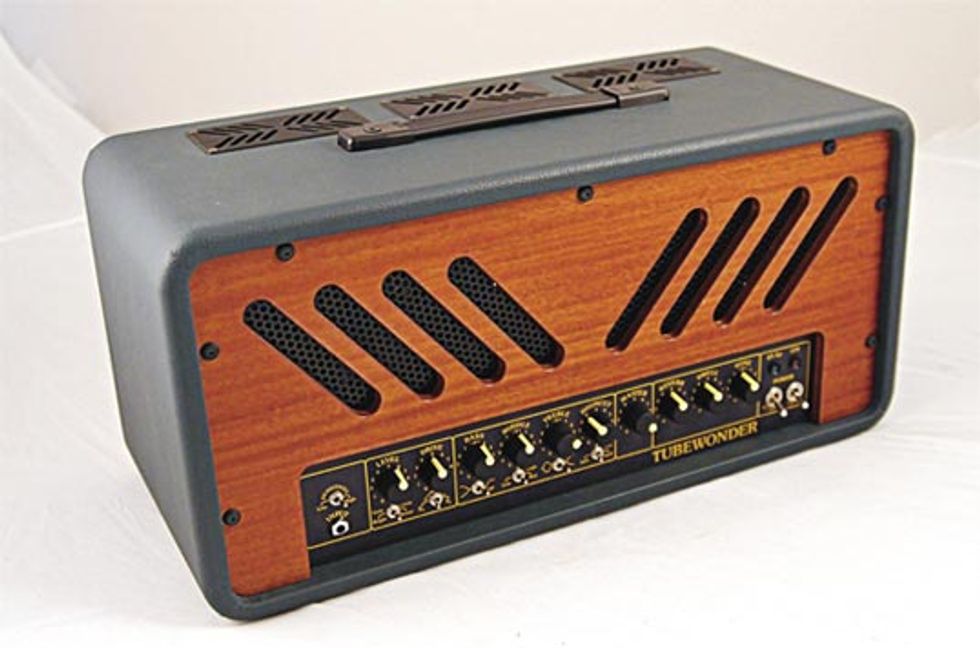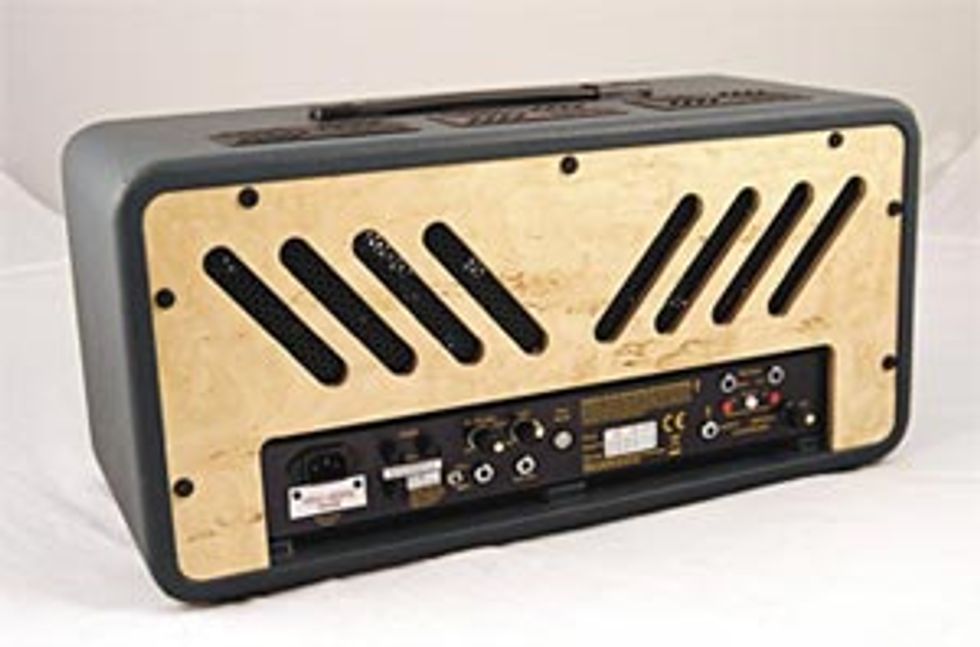
“I don’t know if that cabinet will work – the Tubewonder is kinda finicky about speaker cabinets,” offered the voice on the other end of the phone. It was Tubewonder’s U.S. distributor responding to my plan to use a Mills Acoustics 4x12 cab loaded with Celestion V30s to review the Tubewonder. All I could manage for a response was a muttered “Ah, shit!” under my breath.
Picking out speaker cabinets can be daunting, especially when trying to find something that can work well under multiple guises. I thought we had located one that could handle all that we needed – clean, crunch and all out distortion, yet here was this guy on the other end of the phone unintentionally pissing in my Cheerios.
“How about we try it and see what happens?” I offered, audibly this time. He responded, “Sure, just let me know if you want me to send out a different cab.” Great, I thought. Waiting for another cab to arrive would put us even further behind schedule – that will make my editor happy. I mumbled thanks and hung up. Once the amp arrived and was unboxed from its shipping carton, I was treated to something resembling the unholy union of Alembic (circa 1975) and Ming the Merciless (circa 1936), in part due to the Tubewonder’s interesting mixture of art deco-inspired cut outs and hippy-dippy, tweaker-gone-to-heaven control layout. This is not to infer that the amp is unattractive. Quite the contrary, the darkstained wood faceplate and green vinyl faux-leather covering deliver busy but solidly handsome looks. It just doesn’t look like much else out there.
The included box full of tubes, fuses, a t-shirt and a user manual shines a little light into the inner workings of designer Aleksander Niemand’s mind. The handwritten rectifier tube suggestions on the manual’s cover speak volumes about Alex’s amp building motivation. I began to think, cabinet gods willing, that I was really going to enjoy this amp. The next bit from the manual’s cover cinched it: “TUBEWONDER is an unusual amplifier. Period.”
Making sure the mix of two KT66s, five 12AX7s, a single 12AY7 and GZ34 were all firmly in place, I selected the correct impedance and plugged into the Mills Afterburner cab, attached the included footswitch, plugged in my trusty Nocaster and powered up. The only thing between my guitar and the amp was ten feet of George L’s. Looking down at the footswitch indicated that the reverb was engaged, so I glanced over at the chassis to find that the Reverb, Dwell and Tone controls were all at noon. In fact, all of the controls happened to be at noon, per the manual’s suggestion: “Set all the knobs at 12 o’clock; try different footswitch combinations. Twiddle the knobs to FREE YOUR TONE. Forget the amp and just make music!”

"She may have won the award for under-statement of the year. The Tubewonder is basically a blank canvas that provides the tonal flexibility to give the player what they want..."
I should mention that my wife was in the room with me as I went about all of this. She was telling me about how she wanted to buy a Vincent Black Lightning for my birthday this year, or that we should move to Jamaica or something about winning the lottery. I’m not entirely sure, because as soon as I hit a chord through the amp her lips continued to move but I didn’t hear a word. All I could hear was my guitar: no hokum, no trickery, no mid-humps or smiley-face EQs – just my guitar with full, slightly compressed, glass-like sustain. Imagine plugging a guitar into an old McIntosh mono-block tube amp to grasp how this amp sounds clean. Thick yet defined, articulate and unified, all with that glorious touch of compression delivering a seemingly inordinate, yet still natural- sounding, amount of sustain. “Do you hear that?” I asked. “Sure,” she replied. I threw her another question: “Is it messing with your head, too?” “Yeah,” she offered with a half grin and a twinkle in her eye. “It sounds amazing.”
She may have won the award for understatement of the year. The Tubewonder is basically a blank canvas that provides the tonal flexibility to give the player what they want – not what Leo Fender envisioned, or Jim Marshall or Dick Denney, but what you want – delivered at all times with impeccable tone. But the bonus is that with everything set flat, the amp still sounds phenomenal.
 Kicking in the reverb via the footswitch delivered even more smiles with the Tubewonder’s take on what full, lush reverb should sound like, although the post-EQ Reverb mix starts robbing volume past six, due to the interaction between preamp Level and reverb Dwell controls when Level is set low. How do I know all this? The user manual, natch. Featuring a “Description of Controls” that looks more like the signal flow of an I/O from a vintage Neve console, it speaks directly to the amp’s design ethos – give the user control from the moment they plug in. Reverb controls the proportion between dry and delayed signal from the reverb recovery amplifier. The Dwell control adjusts the reverb signal’s intensity and Tone offers up EQ options for the delayed signal, which isn’t affected by the amp''s EQ, because the signal is split off before the EQ.
Kicking in the reverb via the footswitch delivered even more smiles with the Tubewonder’s take on what full, lush reverb should sound like, although the post-EQ Reverb mix starts robbing volume past six, due to the interaction between preamp Level and reverb Dwell controls when Level is set low. How do I know all this? The user manual, natch. Featuring a “Description of Controls” that looks more like the signal flow of an I/O from a vintage Neve console, it speaks directly to the amp’s design ethos – give the user control from the moment they plug in. Reverb controls the proportion between dry and delayed signal from the reverb recovery amplifier. The Dwell control adjusts the reverb signal’s intensity and Tone offers up EQ options for the delayed signal, which isn’t affected by the amp''s EQ, because the signal is split off before the EQ. The Low/High Sensitivity switch at the amp’s Input sets the tone for the amp’s layout – switches offer multiple capabilities for recognizable controls. The Level control offers Bright, Normal and Boost modes, offering +4 dB of boost at 4k, no boost and a +4 dB full-range boost, respectively. The Drive control features a switch to choose from mostly even or mostly odd order harmonics, offering a glimpse into this amp’s flexibility, as well as illustrating how this amp can handle most anything. If you will recall, the Tubewonder distributor had some apprehension about the Mills cabinet, and as it turns out, the concerns weren’t completely misplaced. The Mills delivers enough bottom-end to make a Texan envious and the resulting lows were somewhat overpowering. Simply kick in the high-pass filter – centered at 125Hz with a 12dB drop – via the switch below the Bass control, then add a little bass, which is centered around 150Hz, to tighten things up. After the tweaks, the Tubewonder delivered plenty of punch without boominess.
Just for grins, I decided to create a huge blackface tone – imagine James Burton on a high-end, Swedish amp jag. I started by engaging the Bass control’s high-pass filter and boosting the Bass EQ control to one. It should be noted that, again, like a high-end studio console, the active, semi-parametric EQ on the Tubewonder is extremely sensitive, and will have you conceptualizing small, incremental EQ changes in no time. You may even become one of those subtractive EQ zealots if you’re not careful. The Middle control was left at zero and the shelving contour was engaged at the Treble control, which was then boosted to two-and-a-half. The manual suggests switching in the Highcut filter to take the edge off of single coils in this instance, so after setting the corresponding switch to the “Soft” position – setting the cut-off frequency at 900Hz – I located my sweet spot, stopping just shy of four. I found with the Level control at five and the Master cranked up to eight or nine that the clean tones really bloomed, taking on an even more pronounced depth.
Kicking in the Drive switch on the footpedal again pointed to this amp’s design, with Level, Drive and Master controls being very interactive and exceedingly flexible. Simply cranking the Drive knob and rolling back the Master is not the way to go, delivering this amp’s most unsatisfying tones. Instead, keep the Master a little hot; the Drive control will become your BFF. Alternately, running the Level control a little hot with the Master at noon delivers a different kind of (great) grit with more compression and focus by hitting the EQ section harder. The footswitch also includes a Boost switch, working with both the normal and Drive channels, delivering an additional 4dB of clean boost. Alternately, you can use the footpedal’s Loop switch to engage the parallel/series effects loop, which can be set up to provide an additional boost when no effects are present.
Our sample’s KT66s no doubt help explain the glorious mix of clean and overdriven tones that we achieved, but the Tubewonder can also take 6L6s or EL34s, requiring just the manual and a digital multimeter to set the bias via the included test points on the back of the chassis. Users can also switch between GZ34, 5U4GB or solid-state rectifiers to tailor their preferences right down to the amp’s feel and response.
The Final Mojo
All in all, this thing is a monster for the player that wants to find his or her own sound. I found myself starting with benchmark tones, then, after being waylaid by all of the options, developing my own version of a big, bold, clean tone, or a compressed, dry, overdriven snarl. With the Tubewonder, words like “tweedy” or “British” describe the start of the journey, not the destination.
Buy if...
you would like to spend some quality time developing your sound
Skip if...
your bread and butter is covering established tones
Rating...
MSRP $6373 - Tubewonder - anacon-tech.com |
Our expert has stated their case, now we want to hear yours. Share your comments and ratings below.






















































